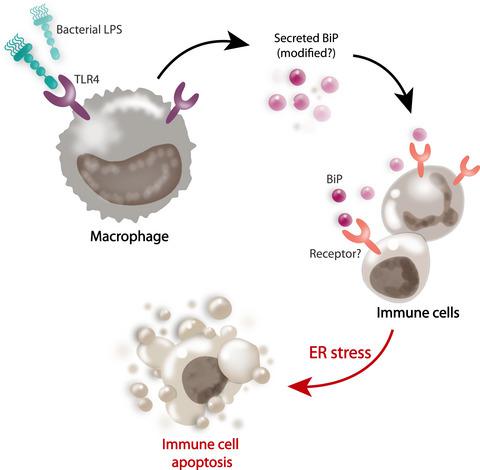Our official English website, www.x-mol.net, welcomes your
feedback! (Note: you will need to create a separate account there.)
Circulating BiP/Grp78 is a novel prognostic marker for sepsis‐mediated immune cell death
The FEBS Journal ( IF 5.5 ) Pub Date : 2020-09-07 , DOI: 10.1111/febs.15552 Marcel Doerflinger 1, 2, 3 , Boris Reljic 1, 2 , Joseph Menassa 1 , Christina Nedeva 1 , Irvin Jose 1 , Pierre Faou 1 , Liana Mackiewicz 2, 3 , Ashley Mansell 4 , Marc Pellegrini 2 , Richard Hotchkiss 5 , Hamsa Puthalakath 1
The FEBS Journal ( IF 5.5 ) Pub Date : 2020-09-07 , DOI: 10.1111/febs.15552 Marcel Doerflinger 1, 2, 3 , Boris Reljic 1, 2 , Joseph Menassa 1 , Christina Nedeva 1 , Irvin Jose 1 , Pierre Faou 1 , Liana Mackiewicz 2, 3 , Ashley Mansell 4 , Marc Pellegrini 2 , Richard Hotchkiss 5 , Hamsa Puthalakath 1
Affiliation

|
Sepsis remains to be a major contributor to mortality in ICUs, and immune suppression caused by immune cell apoptosis determines the overall patient survival. However, diagnosis of sepsis‐induced lymphopenia remains problematic with no accurate prognostic techniques or biomarkers for cell death available. Developing reliable prognostic tools for sepsis‐mediated cell death is not only important for identifying patients at increased risk of immune suppression but also to monitor treatment progress of currently trialed immunotherapy strategies. We have previously shown an important role for endoplasmic reticulum stress (ER stress) in inducing sepsis‐mediated cell death and here report on the identification of a secreted form of the ER chaperone BiP (immunoglobulin binding protein) as a novel circulating prognostic biomarker for immune cell death and ER stress during sepsis. Using biochemical purification and mass spectrometry coupled with an established in vitro sepsis cell death assay, we identified BiP/Grp78 as a factor secreted by lipopolysaccharide‐activated macrophages that is capable of inducing cell death in target cells. Quantitative ELISA analysis showed significantly elevated levels of circulating BiP in mice undergoing polymicrobial sepsis, which was absent in Bim−/− mice that are protected from sepsis‐induced lymphopenia. Using blood serum from human sepsis patients, we could detect a significant difference in levels of secreted BiP in sepsis patients compared to nonseptic controls, suggesting that secreted circulating BiP could indeed be used as a prognostic marker that is directly correlative to immune cell death during sepsis.
中文翻译:

循环BiP / Grp78是败血症介导的免疫细胞死亡的新型预后标志物
败血症仍然是ICU死亡率的主要因素,由免疫细胞凋亡引起的免疫抑制决定了患者的总体存活率。但是,由于没有准确的预后技术或细胞死亡的生物标志物,脓毒症引起的淋巴细胞减少的诊断仍然存在问题。为脓毒症介导的细胞死亡开发可靠的预后工具,不仅对确定免疫抑制风险增加的患者很重要,而且对监测目前试验的免疫疗法策略的治疗进展也很重要。先前我们已经显示了内质网应激(ER应激)在诱导败血症介导的细胞死亡中的重要作用,并在此报道了鉴定一种分泌形式的ER伴侣BiP(免疫球蛋白结合蛋白)作为免疫的新的循环预后生物标志物的报道。败血症期间细胞死亡和内质网应激。使用生化纯化和质谱联用建立在体外败血症细胞死亡测定中,我们确定BiP / Grp78是脂多糖激活的巨噬细胞分泌的因子,能够诱导靶细胞的细胞死亡。定量ELISA分析显示,经历了败血症的小鼠中,循环BiP的水平显着升高,而在受到败血症诱导的淋巴细胞减少的保护的Bim -/-小鼠中,这是不存在的。使用败血症患者的血清,我们可以检测出败血症患者与非败血症对照组相比分泌的BiP水平有显着差异,这表明分泌的循环BiP确实可以用作与败血症期间免疫细胞死亡直接相关的预后标志物。
更新日期:2020-09-07
中文翻译:

循环BiP / Grp78是败血症介导的免疫细胞死亡的新型预后标志物
败血症仍然是ICU死亡率的主要因素,由免疫细胞凋亡引起的免疫抑制决定了患者的总体存活率。但是,由于没有准确的预后技术或细胞死亡的生物标志物,脓毒症引起的淋巴细胞减少的诊断仍然存在问题。为脓毒症介导的细胞死亡开发可靠的预后工具,不仅对确定免疫抑制风险增加的患者很重要,而且对监测目前试验的免疫疗法策略的治疗进展也很重要。先前我们已经显示了内质网应激(ER应激)在诱导败血症介导的细胞死亡中的重要作用,并在此报道了鉴定一种分泌形式的ER伴侣BiP(免疫球蛋白结合蛋白)作为免疫的新的循环预后生物标志物的报道。败血症期间细胞死亡和内质网应激。使用生化纯化和质谱联用建立在体外败血症细胞死亡测定中,我们确定BiP / Grp78是脂多糖激活的巨噬细胞分泌的因子,能够诱导靶细胞的细胞死亡。定量ELISA分析显示,经历了败血症的小鼠中,循环BiP的水平显着升高,而在受到败血症诱导的淋巴细胞减少的保护的Bim -/-小鼠中,这是不存在的。使用败血症患者的血清,我们可以检测出败血症患者与非败血症对照组相比分泌的BiP水平有显着差异,这表明分泌的循环BiP确实可以用作与败血症期间免疫细胞死亡直接相关的预后标志物。











































 京公网安备 11010802027423号
京公网安备 11010802027423号